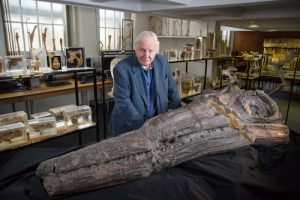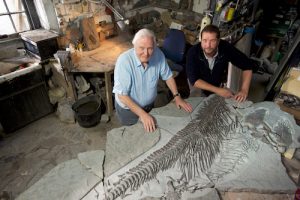Communiqué
NATURE: Attenborough & the Sea Dragon Premieres Wednesday, January 9 at 8
< < Back to nature-attenborough-and-the-sea-dragon-premieres-wednesday-january-9-at-8Nature: Attenborough and the Sea Dragon
Premieres Wednesday, January 9 at 8 p.m.
Streams Thursday, January 10 at pbs.org/nature and on PBS apps

A remarkable chance discovery is about to reveal secrets that have laid hidden for 200 million years. A “dragon” that ruled the ocean at the time of the dinosaurs was found in the eroding cliffs on the southeast coast of England called the Jurassic Coast. It’s an Ichthyosaur, a fish lizard. This fearsome predator had the very best characteristics of reptiles and mammals in one formidable package. It could regulate its own body temperature, had astonishingly acute eyesight, and an impressive set of blade-like teeth and powerful, gripping jaws to hunt and swallow its prey whole. As the forensic investigation unfolds, fossil hunter Chris Moore and his team stumble into the 200-million-year-old murder mystery of this extraordinary creature’s fate. Sir David Attenborough hosts this detective story, from the challenging on-site extraction of the fossils to the 3D reconstruction of the creature. He looks at evidence from animals across the world to try and piece together how this super predator lived and died.
Noteworthy Facts:
• Ichthyosaurs dominated the seas for more than 150 million years and died out around 90 million years ago.
• The first complete skeleton of an ichthyosaur was discovered in Dorset, England, in 1811 by Mary Anning, a self-taught fossil hunter. When a photo of it was published in 1814, people believed it to be a fish lizard or a sea dragon. Since that time, many fossil fragments of ichthyosaurs have been discovered on the Jurassic coast, but complete skeletons are very rare.

• It’s extremely rare to find a new species of ichthyosaur – only nine have been discovered in the last 200 years.
• The Temnodontosaurus was one of the largest of the ichthyosaurs. This predator grew up to 33 feet long and had the largest eyes known of any animal. It also had rows of sharp teeth and crocodile-like jaws that would have allowed it to rip apart almost anything – including smaller ichthyosaurs.
• Dolphins and ichthyosaurs have several characteristics in common, indicating that they may have both evolved from ancestors that once lived on land. Both steady themselves as they turn through the water using their front paddles and dorsal fins. However, ichthyosaurs also have back paddles, while dolphins have flattened horizontal tails that drive themselves forward by beating up and down. Ichthyosaur tails were flattened vertically, like those of sharks.
Buzzworthy Moments:
• The discovery of a new species of ichthyosaur begins in Dorset on the south coast of England – one of the most important geological sites in the world. Archaeologist Chris Moore and his excavation team carefully dig by hand along the side of a cliff to minimize damage to the fossils. Rough seas and heavy downpours turn the excavation into a perilous process.
• Once the fossil is uncovered, several signs point to it being a new species of ichthyosaur, including the large size of the paddle and the arrangement of the bones. Bigger than most ichthyosaurs discovered in the area, it’s estimated to have been up to 15 feet long.
• The team also finds signs of fossilized skin – a very rare occurrence. Fiann Smithwick, an expert on fossilized skin, determines that this ichthyosaur conformed to a type of color pattern known as “counter shading,” which allowed it to be camouflaged in the open seas as well as protected against ultraviolet light. This is the first time that evidence of a counter-shaded pattern in an ichthyosaur has been discovered.

• After weeks of work, Moore and the team expose the backbones and ribs of the fossil and make a startling discovery. Breakages through the rib cage and a missing head suggest that it was attacked and killed by a much bigger animal, most likely a temnodontosaurus. A vivid computer animation reimagines this epic battle at sea – and what happened to our fallen ichthyosaur.
Nature is a voice for the natural world, bringing the wonders of wildlife and stories of conservation to millions of American viewers. Nature has won more than 700 honors from the television industry, the international wildlife film communities and environmental organizations, including 18 Emmys and three Peabody Awards.
Production Credits:
Nature is a production of THIRTEEN PRODUCTIONS LLC for WNET and PBS. For Nature: Fred Kaufman is Executive Producer. Bill Murphy is Series Producer and Janet Hess is Series Editor. Attenborough and the Sea Dragon is a BBC Studios production for PBS and BBC with THIRTEEN PRODUCTIONS LLC. The documentary is produced and directed by Sally Thomson. Michael Gunton is Executive Producer. Edited by Mike Denny. Cinematography by Robin Cox. Original Music by Alex Stoloff. Presented by David Attenborough.

